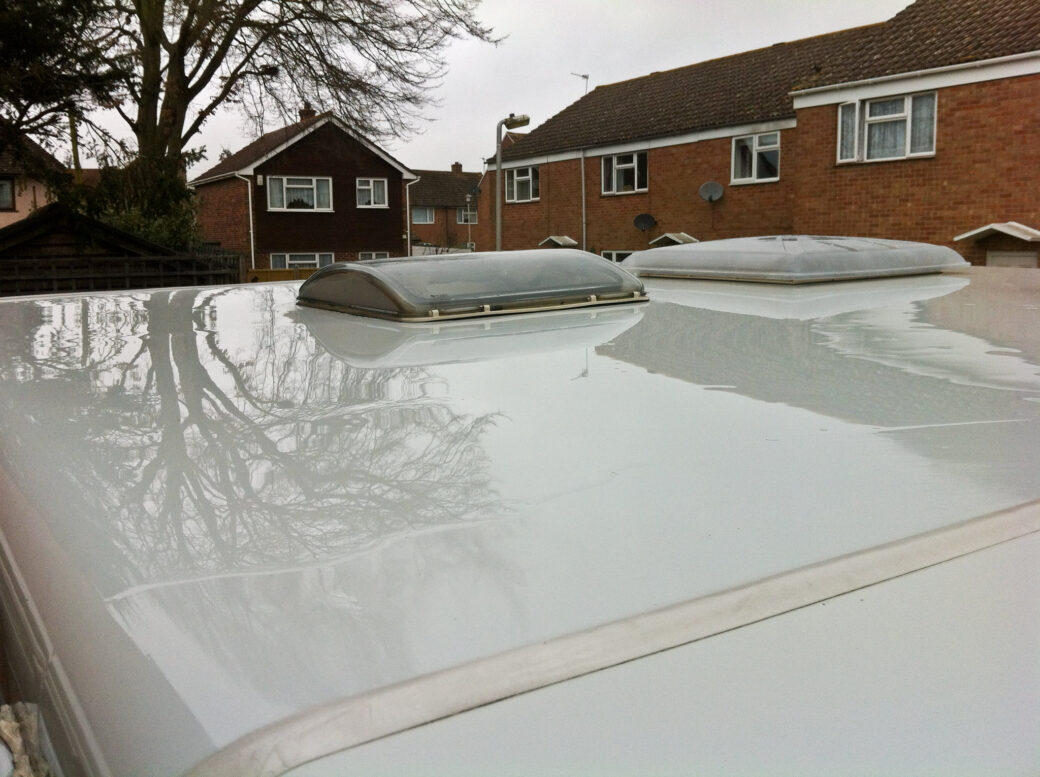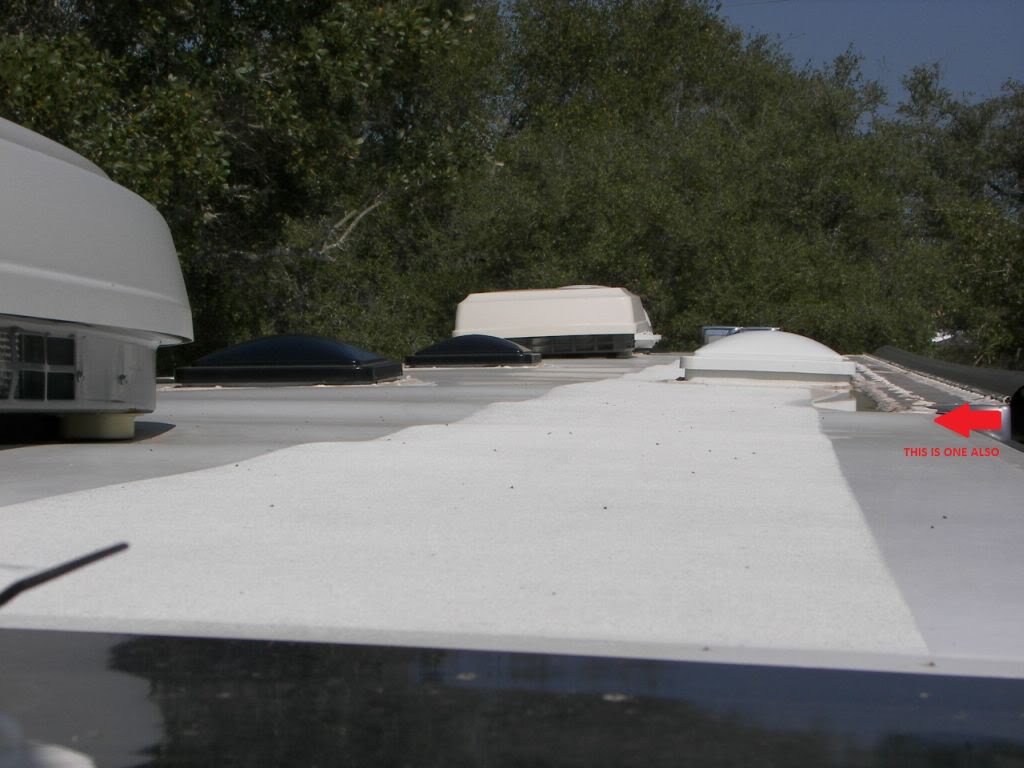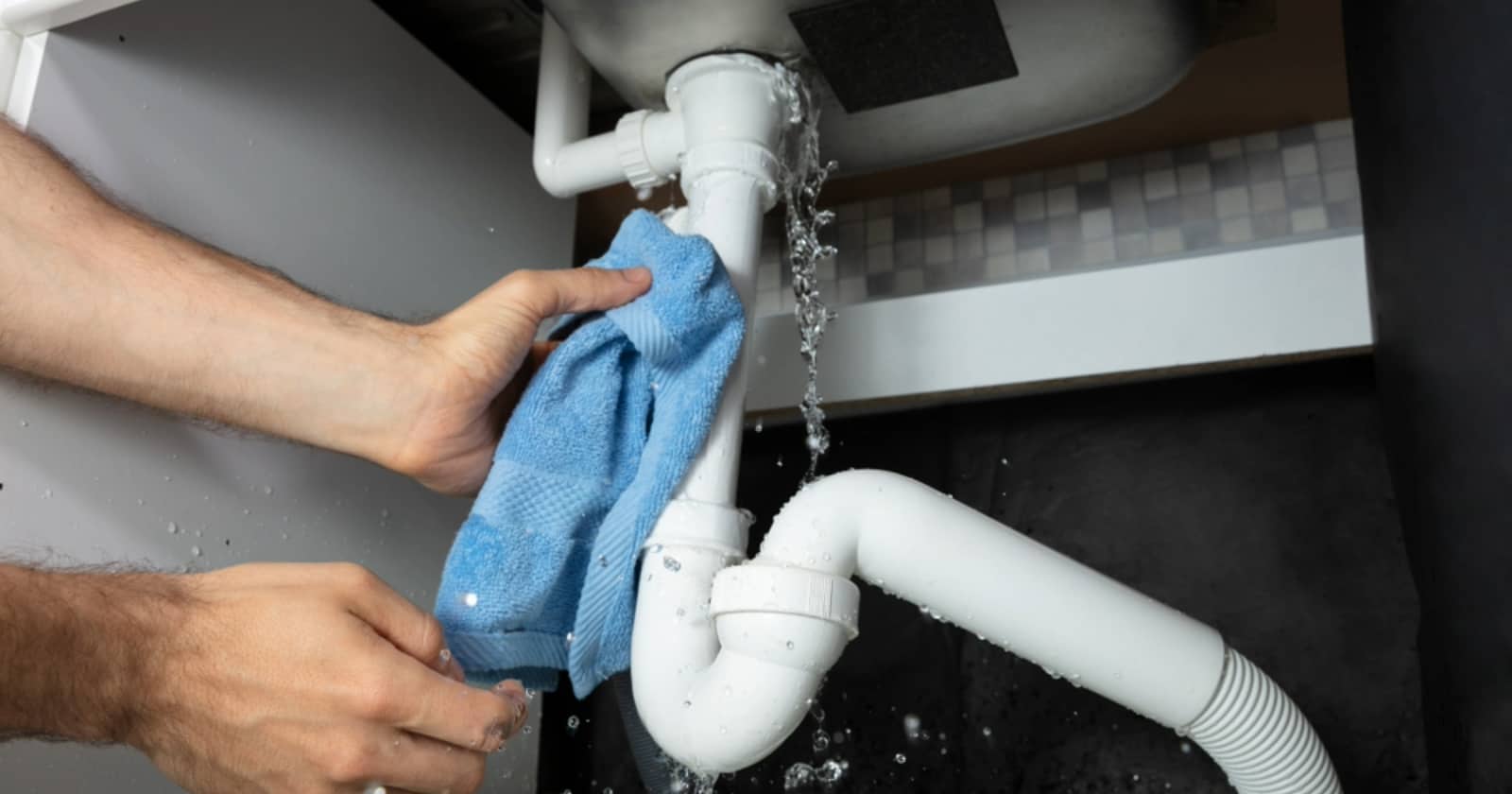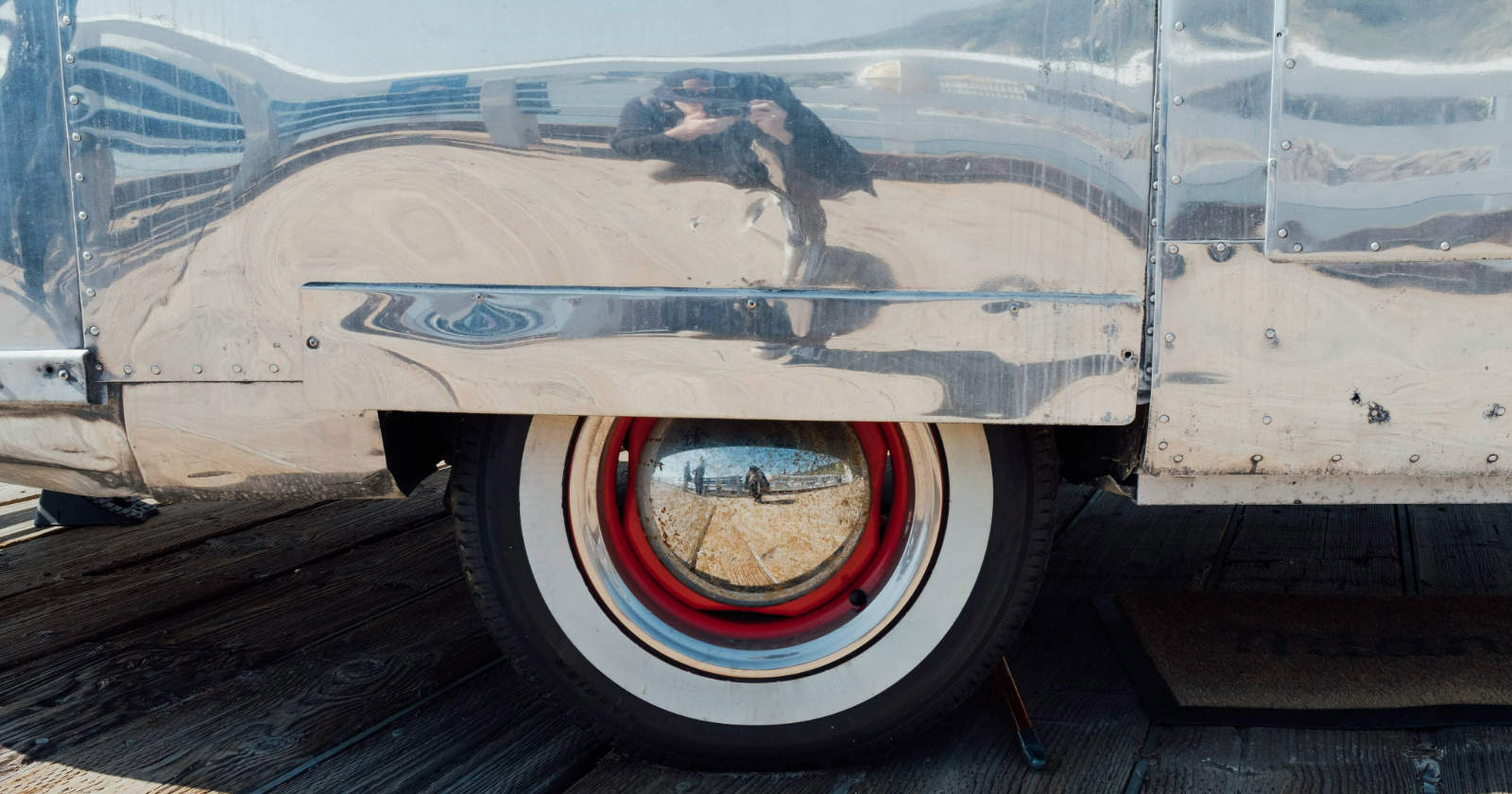The quickest way to lose all that hard-earned equity in your RV is assuming the roof over your head will last forever without any maintenance at all.
The truth of the matter is that water damage is the leading cause of major repairs in all types of RVs. When water from rain or melted snow seeps through a seam, you’ll quickly end up with ruined insulation, damaged wall panels, and even rotted framework.

RV roof maintenance
Some nasty types of mold like to grow in areas that have suffered water damage as well. The time to take care of water leaks is well before they actually happen.
It’s not only the summer rain that can lead to water damage problems. If you live or travel with your RV around most of the US in the colder months, you’ll also have to deal with the normal freeze and thaw pattern.
Unlike most other materials, when water freezes, it expands. This expansion can enlarge seams and cracks on your roof, creating a pathway for water to enter your RV.
To prevent damage from this freeze and thaw cycle, you’ll have to do two things:
- Inspect your RV roofing material well before freezing temperatures hit
- Quickly repair your roof with appropriate sealants and techniques
RV roofs aren’t all the same
RV roofs come in an assortment of materials, and each must be attended to in a different way.
Does this make life difficult if you’re worried you’ll apply the wrong material? Not if you follow the information described in this guide.
A good rule of thumb is that if the product is designed to be used on your sticks-and-bricks home, you probably shouldn’t be using it on your RV.
So before you buy a 5-gallon bucket of a tar-based, silver-colored roof coating, beware…it’s a huge mistake that will most likely reduce the resale value of your RV.

Rubber RV roof maintenance and repair
Rubber roofs are generally dependable and long-lasting, but you’ll need to understand the difference between the two main types of materials to ensure proper care.
You may think that since your local home center sells rubber roof membranes for homes, they’ll carry supplies that are designed specifically for your RV rubber roof, right?
Not exactly!
Most RV manufacturers use one of two types of rubber roofing material: EPDM and TPO. Let’s take a look at both.
EPDM Rubber Roofs
EPDM roofs are usually maintenance-free, at least for the first ten years after they’re installed.
Contrary to popular belief, there isn’t too much you need to do with an EPDM rubber roof, other than maybe wash it down with soap and water every once in a while.
Because of the unique structure of EPDM, you don’t have to apply any sort of UV protectant to it or routinely re-coat its surface.
However, the use of any harsh chemicals or petroleum-based products on an EPDM rubber roof will cause irreparable damage.
Making a mistake here could get expensive real quick. The last thing you want to do is replace your rubber roof.
If you’re buying a used RV that has a rubber roof, check to see if it looks swollen, uneven, or loose. If you notice any of these issues, chances are good the previous owner used petroleum-based products on their EPDM roof—find a different RV!
Over time the surface of the EPDM will develop a chalky look to it, and you may get some white streaking down the side of the rig from EPDM residue washing off the roof when it rains.
The chalky look is normal. This layer actually protects the rubber roof from degrading beyond a certain point. The chalky layer is oxidized EPDM, and it protects the unoxidized EPDM beneath it, sort of how the outer layer of dead skin cells protects our body.
But EPDM does have a useful lifespan, and eventually, it will require either replacement or re-sealing.
If you’re noticing deterioration, you might want to consider sealing it up using a couple of different products.
Whichever product you use, be sure to read the directions carefully to make sure it’s designed for an EPDM roof. The good news is that if you’re a handy person, resealing your EPDM roof is quite similar to sealing an asphalt driveway.
Dicor and EPDM Coatings make some highly-rated products for resealing EPDM. Make sure to get the right color, you can usually choose from white or black.
If you choose to use Dicor, you’ll need to apply two coats of it AFTER using the company’s cleaner/primer. EPDM Coating’s roof sealant, on the other hand, requires a mixed in activator to prep the sealant.
Here’s a couple of videos showing how to apply each type of product.
How to apply the Dicor EPDM coating:
How to apply EPDM Coating’s Liquid Rubber.
Note, Liquid Rubber requires a catalyst while the Dicor EPDM coating doesn’t:
TPO Rubber Roofs
TPO roofs are made of a different material than EPDM roofs. TPO has a shiny look to it and is much more rigid than EPDM. It’s less rubbery and more plastic-y.
TPO, unlike EPDM, won’t oxidize and get a chalk-like outer surface.
An occasional washing with some mild soap and a mop is all that you’ll need to do to care for a TPO roof. A few products that I’ve seen used are Protect-All Rubber Roof Treatment and Murphy’s Oil Soap. The Murphy’s Oil Soap will help keep the TPO membrane ‘moisturized’ according to one manufacturer, Alpha Systems.
These washings are mostly to make the surface look better, and won’t make the TPO roof last any longer.
You can read more about the technical differences between EPDM and TPO roofs here.
How to seal a metal RV roof
Metal was the RV roofing material of choice before TPO and EPDM took over.
Though household roof coatings may work to steal your RV metal roof, it’s best to stay away from them.
The best product to use on a metal roof is Kool Seal.
Kool Seal is a reflective white coating that not only seals minor imperfections but also helps keep the inside of your rig cool.
Give your air conditioner a hand and protect your roof from leaks at the same time.
Here’s a video done by a couple of guys who resealed their metal roof using Kool Seal.
Sealing an RV metal roof the easy way
Sometimes you don’t need to just seal a roof, you need to repair it structurally. A great product for repairing your RV roof is EternaBond seam tape.
This is the perfect product no matter what kind of roof you have.
EternaBond seam tape comes in rolls 4” wide that you apply over any seams on your roof. You’ll want to take a close look at the front and rear ‘caps’ of your roof to make sure that there are no seams between the panels.
These cap joints experience a lot of torque as the RV rolls down the road or travels over uneven ground (AKA everywhere).
Not only will EternaBond protect those major seams, but it’s also the ideal product to carry in your toolbox for emergency repairs—sort of like a specialized duct tape.
The stray branch that caught the TV antenna and ripped the rubber membrane off the roof? Use a strip of EternaBond over the tear and you’ll never have to worry about it again.
After you have cleaned the damaged roof material, you simply peel off the protective cellophane and press the tape over the damage. Once down, you are not going to be able to peel it back up for adjustment.
Make sure to get the placement right the first time.
Other types of roof sealers for small RV repairs
For spot fixes, you might consider certain caulk products. Flow Seal is a semi-liquid product that comes in a tube-like caulk.
You can squeeze it over a seam, wet or dry, and it will self-level over the area to form a rubbery pad. It’s especially good for fixing gaps around windows.
Geocel also makes a clear, flexible sealant that is great for small spot repairs.
Fiberglass RV roof maintenance
Fiberglass RV roofs oxidize over time, just like EPDM rubber roofs.
And if your fiberglass RV is an older one, chances are good that the manufacturer didn’t put a clear coat finish over the gel coat, which results in even faster oxidation of your roof.
If you’ve got an RV with a fiberglass roof, take a look at this article for how to remove gel coat oxidation and bring back the shine.
RV roof maintenance is an important part of the care and feeding of your rig. While modern RV roofing materials will last for years and years, nothing lasts forever.
Eventually, you’ll need to take some action against the inevitable effects of oxidation and UV damage.
Case in point: while writing this article, I noticed new spider cracks on my RV’s roof that hadn’t been there just last fall. I had better go get some sealer and take care of my own problems before water gets a chance to get inside…
Keep track of your RV roof maintenance
Keep track of all your RV roof maintenance with an online tool such as RV LIFE Maintenance. Not only can you keep all your maintenance records and documents in one place, you’ll receive timely reminders via email when maintenance is due, and potentially avoid a costly repair due to lack of maintenance.
Whether you have a small camper or large class A motorhome, RV LIFE Maintenance can keep track of it all. Keeping accurate maintenance records also increases your resale value, should you ever decide to do so.




Can I use “Flex Seal liquid rubber” to coat a 2001 Cari-Go by Carraige rubber roof ?
I sealed my motorhome with Tropi Cool by Henry Roofing Materials. Home Depot and Lowe’s both carry it.
the rear wall in our 1992 Travelaire all of a sudden showed swelling and buckling in about an 8″ square area near the rear window and the wallpaper had pulled away from the little seam cover strip. With dread, we knew instantly it was water damage but wondered it could have happened as it wasn’t there a week before when we made up the bed and there had been no rain. Another strange thing is that it was spongey or soft but dry, not wet. We are not the original owners but have had the trailer for many years and have an RV tech seal and search for small cracks on the roof every two years and have had it completely resealed twice. We figured it had to be the back window. Well, turns out it had nothing to do with the window, and this is what really baffled us, it most likely occurred around 5 years ago! It just now became visible due to dry rot inside. We were told that even a teaspoon of water that gets into a teensy almost invisible crack every time it rains will seep down and collect and then wick back up the wood causing rot until one day it just shows itself. This can even happen with a brand new unit off the dealers lot!! The sun bakes the roof depending how long it’s been sitting and causes cracks and you buy it unawares and 5 years later get a leak but the damage and leaking started long before and just was hidden in the wall as it wicks and rots. Note: If you can, try to store your unit under a carport type roof. I have seen the tarps but was told to avoid them as they cause mildew – think I’d rather be trying to get rid of a bit of mildew right now but anyways….
We are now left with our back wall starting to come apart and don’t know if it can be fixed. Our trailer is an oldie but a true goody and we don’t want to lose it. We can still use it but of course it’s value just went right down. Other than that we have kept it in excellent condition and it’s a great unit.
Thought I’d throw this out there to you all and see if you have any ideas on what it would cost to fix, or if there is even a way to fix it? We are prepared for it not being cheap of course but our RV tech just sadly shook his head and said the cost would be prohibitive and it would be a major restoration. He said you just don’t know how far reaching the damage is inside the wall even though it’s only about an 8″ square area visibly.
Help! Any ideas would be greatly appreciated!
We will be camping under pine trees for one month. Any ideas on how to protect the roof from sap etc? Learned a lot from the roof care article. Thanks
Im 63 – got an older rv – fiberglass –
Got some roof leaks –
Suggestions please